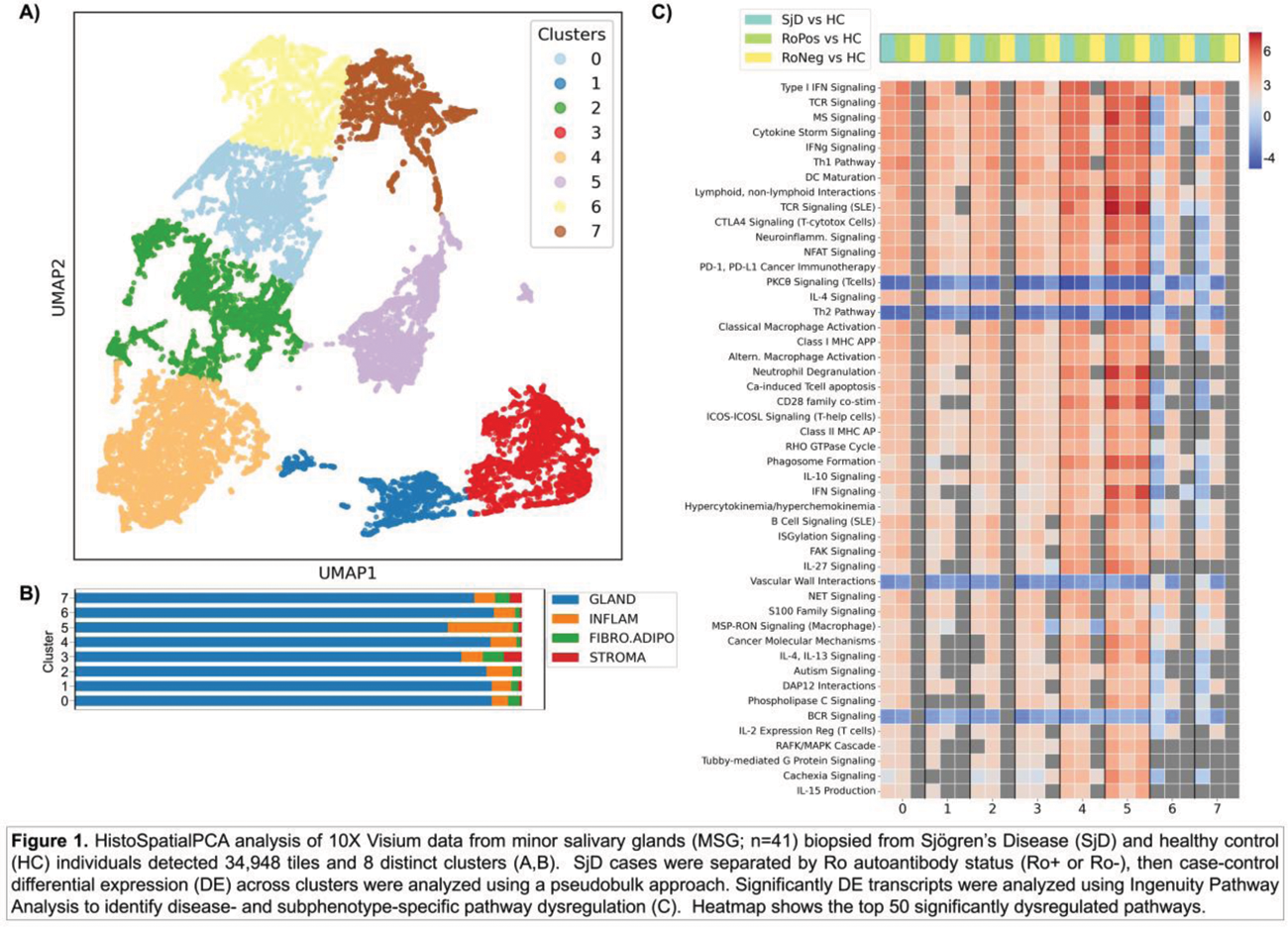

Background: 10X Visium spatial transcriptomics evaluates mRNA-binding tiles (55μm diameter) of a sectioned tissue, yielding heterogeneous cell sampling. The SpatialPCA algorithm was developed to identify like tissue regions and determine the cellular context of spatial coordinates using homogenous tissue types with distinct boundaries [1] However, while proficient in analyzing homogenous tissue types, SpatialPCA is less effective at differentiating like tiles from heterogenous tissue types.
Objectives: To develop a novel analysis pipeline, HistoSpatialPCA, that leverages spatially aware dimensional reduction to model spatially correlated structures across tiles from heterogeneous tissue types such as a target tissue of Sjögren’s Disease (SjD), the minor salivary gland (MSG). Then, to apply HistoSpatialPCA to MSGs biopsied from SjD patients and healthy controls (HC) to identify disease-specific differential gene expression (DE) and pathway dysregulation in the salivary gland.
Methods: MSG sections were arranged on 10X Visium capture slide chambers. Nuclei segmentation and classification was performed, followed by images annotation by tissue type (fibrosis, glandular, inflammatory, fat) (HALO Image Analysis Platform). Imaging data were extracted from tiles and integrated with spatial coordinates using HistoPCA. After quality control to filter low-quality and non-tissue tiles, SpatialPCA was performed [1]. Subsequently, data integration (Harmony) and UMAP with KMeans clustering were performed. SjD case-control differential expression (DE) was analyzed using pseudo-bulk gene expression. Finally, DE transcripts were analyzed by Ingenuity Pathway Analysis.
Results: HistoSpatialPCA, followed by UMAP with KMeans clustering, detected 34,948 tiles from n=41 subjects, resulting in 8 distinct clusters in the MSG (Figure 1A,B). Comparison of dysregulated genes and pathways revealed cluster-specific differences between Ro+ and Ro- SjD cases verses HCs (Figure 1C). Ro+ SjD cases exhibited dysregulation across all clusters, whereas Ro- cases showed no significant dysregulated pathways in clusters 0, 2, and 7 and fewer altered pathways in clusters 1 and 6. Rank order of the dysregulated pathways also differed between Ro+ and Ro- SjD cases. Interferon gamma was the top pathway in all SjD cases and Ro+ across all clusters, but was only dysregulated in Ro- cluster 5 and modestly in clusters 1 and 3. Cluster 5 was the most similar between Ro+ and Ro- and showed the highest percentage of inflammation (upregulation of many proinflammatory pathways; downregulation of CTLA4, IL-10, and PD-1 signaling).

Conclusion: HistoSpatialPCA successfully grouped like tiles from spatial transcriptomic analysis of heterogeneous MSG. Cluster annotation, followed by DE and pathway analyses revealed dysregulation of tiles across all clusters in Ro+ SjD cases, while Ro- cases exhibited the most pronounced dysregulation in cluster 5, 4, and 3. Notably, cluster 5 demonstrated the highest inflammation, sharing many dysregulated pathways between Ro+ and Ro- SjD cases. This spatially aware technology will provide new insights into the role of different cell/tissue types in SjD pathobiology of the salivary gland.
REFERENCES: [1] Shang L, et al. Nat Commun . 2022; 13:7203.
Acknowledgements: National Institutes of Health (NIH): R01ARO7385503 (CJL); R21 DE029302 (ADF).
Disclosure of Interests: Songyuan Yao: None declared, Rick Wilbrink: None declared, Paulina Czarnota: None declared, Matthew Caleb Marlin: None declared, Bhuwan Khatri: None declared, Anna M Stolarczyk: None declared, Cherilyn Pritchett Frazee: None declared, Chuang Li: None declared, Kyle Wright: None declared, Kandice L Tessneer: None declared, Judith A. James: None declared, R Hal Scofield Received consulting fees from Johnson and Johnson Innovative Medicine (formerly Janssen) and Merk Pharmaceuticals., Indra Adrianto: None declared, Astrid Rasmussen: None declared, Joel M Guthridge: None declared, A Darise Farris Grant/research support from Johnson and Johnson Innovative Medicine (formerly Janssen; ended 12/31/23)., Christopher J Lessard Grant/research support from Johnson and Johnson Innovative Medicine (formerly Janssen; ended 12/31/23).